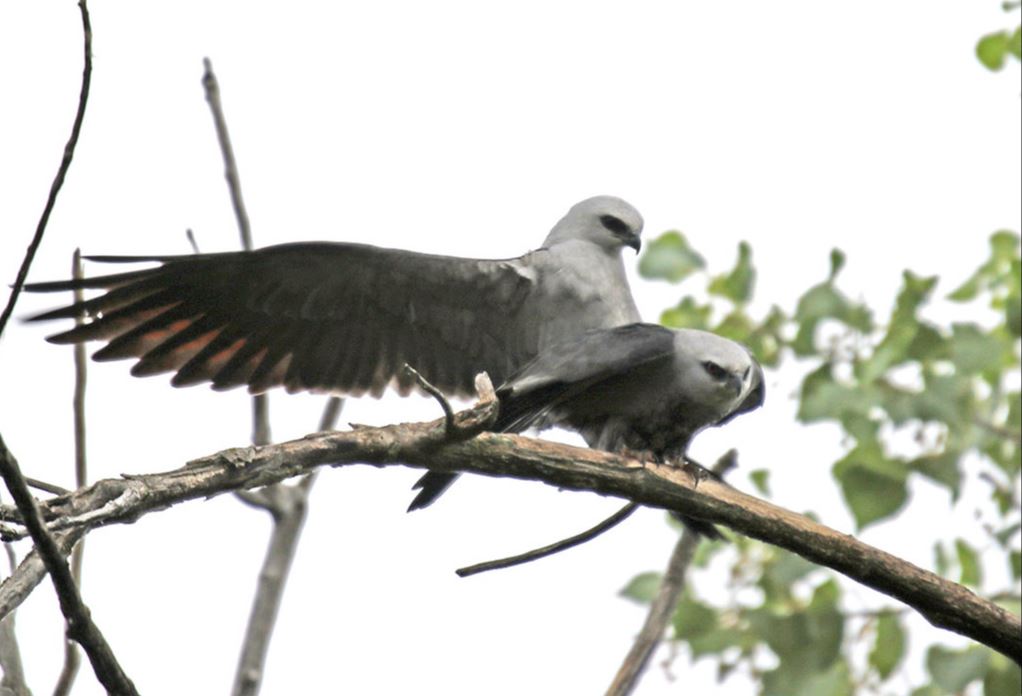BY CJ GIBSON
Photo Courtesy
Visitors to the Fort Hays State University campus should be wary of dive-bombing birds when passing between Forsyth Library and Malloy Hall. FHSU’s migratory resident Mississippi Kites have built a nest in that location.
As the birds attempt to protect their nest, they may swoop down and attack passersby on the sidewalk by Forsyth Library.
FHSU Assistant Professor of Biological Services Dr. Medhavi Ambardar specializes in ornithology and said in a campus email to avoid defensive measures by these birds, cross the street to take the sidewalk by Albertson Hall when traveling in this area. The nest area has been roped off to help pedestrians maintain a safe distance.
The nest cannot be moved without causing the parent birds to abandon the nest Ambardar said. The species is also federally protected under the Migratory Bird Treaty Act.
Mississippi Kites call Kansas home primarily due to its tree planting, agriculture, and warm summers and the increased prey those factors bring. This has caused the predatory birds to begin appearing across town.
“We definitely have them on campus, as many people have seen this past week, but I also see them in my neighborhood, which is a bit east of campus, and I’ve seen them driving along Hall Street, on the other side of town by the hospital,” Ambardar said. “They’re all over. They do amazingly well here in town.”
The species is common in the Great Plains and along the Mississippi River up to central Illinois, a fairly small breeding range according to Ambardar.
This nest will probably be active until late summer. Then the birds will migrate south.
The gray and black birds are between the size of a crow and a goose and can be viewed without binoculars, though Ambardar recommends that bird watchers remain at a distance and not linger nearby for too long.
“You might see them soaring gracefully, sitting on power lines, or even catching food in the air. Once you start keeping an eye out for them, you’ll start noticing them everywhere,” she said. “And later in the summer, you’ll start seeing and hearing the babies after they’ve left the nest.”
One of Ambardar’s favorite parts about FHSU’s campus is its wildlife.
“You can sit down on one of the benches in the quad and watch the squirrels trying to get food. When it’s warm, you can see lizards scurrying about between some of the plants, especially over by Picken. And of course, we have lots of great birds that visit campus, and not just in the summer,” Ambardar said.
Other types of birds that Ambardar and her students have seen this year include White-breasted Nuthatches, Downy Woodpeckers, and a Brown Creeper.
According to Ambardar, the squirrels and smaller birds are most affected by the presence of these birds of prey on campus.
“The squirrels on our campus are pretty bold, which a lot of us have probably noticed just seeing them on the quad,” she said. “But small mammals like squirrels are hard-wired to be wary of large birds flying overhead, so they will usually freeze or run to safety.”
Ambardar said smaller birds are similar and will also do other things like alarm calls or even chase after larger birds if those larger birds get too close to the smaller birds’ nests.
“Mississippi Kites mostly eat insects, but they might also eat small mammals or small birds, so those animals definitely will be on the lookout,” Ambardar said. “By and large though, I don’t think the daily habits of these animals are too affected.”
Visit https://www.allaboutbirds.org/guide/Mississippi_Kite/overview for more information about Mississippi Kites, and be careful when crossing South Campus Drive this summer.

